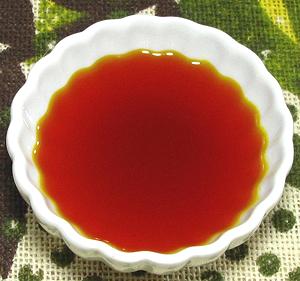 [Elaeis guineensis (African), also
Elaeis oleifera (Americas) and Attalea maripa (Americas)]
[Elaeis guineensis (African), also
Elaeis oleifera (Americas) and Attalea maripa (Americas)]
Dendê oil is much used in parts of West Africa, and in parts of Brazil influenced by Africa, particularly the Bahia region. It is considered essential for the proper color and flavor of dishes from those regions.
This oil is derived from the mesocarp, the red pulp surrounding the fruit of oil palms, not from the palm kernel. It is about 37% monounsaturated fats and 51% saturated fats (kernel oil is over 82% saturated fats), and it is high in vitamin E and antioxidants. The red color comes from alpha-carotene, beta-carotene and lycopene, the same as from tomatoes.
Most Palm Oil production is now in Malaysia and Indonesia, from palms brought from Africa in colonial times. The palm oil used for cooking in Southeast Asia is refined and of a pale yellow color. Most palm oil imported into North America is highly refined and deodorized for use in cosmetics and other processed products. Virgin (red) oils are only produced in Africa and South America.
More on Oils - also,
Oil Composition & Smoke Points.
Buying & Storage:Even in Los Angeles this is not easy to find, except for a few African markets that have plenty in stock. It can be ordered on the Internet. The brand I've purchased is Tropical Traditions, which seems to be a trustworthy vendor of virgin cold pressed oil. Stored in the fridge it'll last a year or three.Settling:A jar of Red Palm Oil will settle with intense red on top and orange lower down. The orange part has some water content.Bleaching:Some African recipes call for "bleaching" the oil. This happens above the smoke point of 380°F/195°C. The bleached oil is a much lighter slightly greenish yellow color, and the flavor is also simpler and less intense.Cooking:This oil does have a distinct flavor, and there seem to be two schools of thought here. Some recipes call for frying in Dendê Oil, others for using a regular oil and stirring in about 2 Tablespoons of Dendê Oil at the end of cooking. If you fry in it, keep the temperature to 350°F/177°C and lower. Smoke point is about 380°F/195°C for virgin oil, but flavor may be partially destroyed by that point.Subst: Some of my West African cookbooks say to use Peanut oil with ground Turmeric for an approximation of both color and taste. Personally, I'd use Coconut Oil to get closer, and a little less than 1/4 teaspoon Turmeric per Tablespoon of Oil seems to work well - not exact, but acceptable. Others say to color the oil with Annatto Seeds, but this just gets you color, no approximation of flavor.Health & Nutrition:The American Heart Association (AHA) pretty much drove palm and coconut oils (together called "tropical oils") out of use in North America with massive publicity campaigns claiming they would destroy your heart. They urged us to use trans fats instead. Guess how that worked out.It is true that tropical oils are high to very high in saturated fats, but the whole saturated fats theory is undergoing reevaluation and appears to have been based on defective research. In any case, tropical oils are making a comeback - some experts think they are the most healthful oils you can use. One thing is certain, they can't be worse than the trans fats long promoted by the AHA, and you survived those (we hope). Dendê Oil is high in alpha-carotene, beta-carotene and lycopene, as well as tocopherols and tocotrienols (vitamin E), CoQ10, phytosterols, and glycolipids - all good stuff. Recent research shows it may provide significant protection to the hearts of rats fed a high cholesterol diet. |